Report on Ambidexterity Approach and its Role in Organizational Change
VerifiedAdded on 2021/01/11
|12
|3217
|26
Report
AI Summary
This report examines the concept of organizational ambidexterity, which involves adapting to two situations simultaneously, focusing on managing change and achieving competitive advantage. The study analyzes how organizations can balance exploitation of existing processes with exploration of new opportunities. It evaluates different operational management and leadership theories, using examples from River Island and Home Office UK to illustrate the practical application of ambidexterity. The report discusses the challenges and benefits of this approach, highlighting 35 initiatives representing unique functional designs. The analysis covers structural and contextual mechanisms, the importance of innovation, and the integration of various leadership styles like situational leadership and theories such as social orientation theory. The report also addresses the use of cross-functional teams and the need for dynamic models to manage change effectively, emphasizing the significance of expert teams from different departments in determining risks and planning innovations.

REPORT ON HOT TOPIC
Paraphrase This Document
Need a fresh take? Get an instant paraphrase of this document with our AI Paraphraser
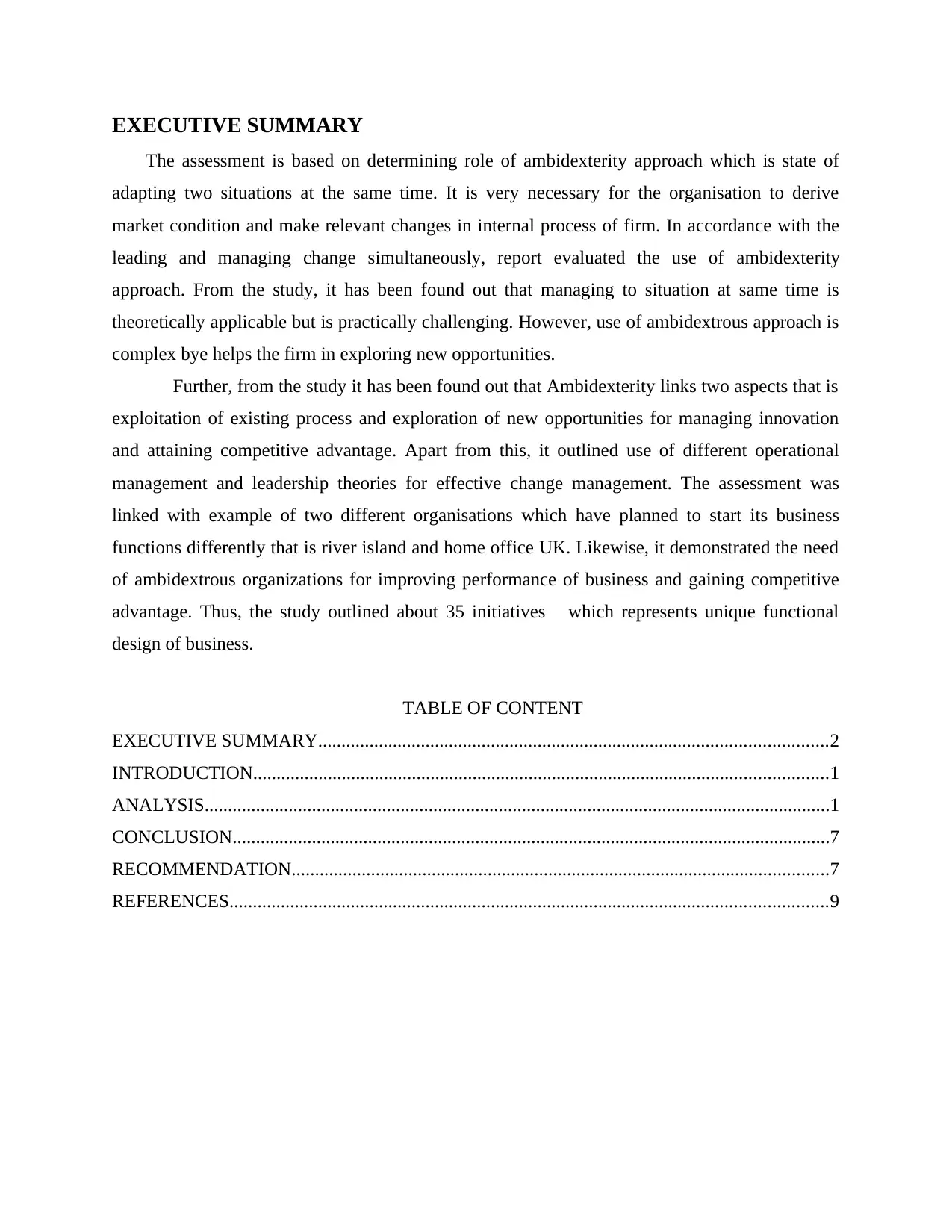
EXECUTIVE SUMMARY
The assessment is based on determining role of ambidexterity approach which is state of
adapting two situations at the same time. It is very necessary for the organisation to derive
market condition and make relevant changes in internal process of firm. In accordance with the
leading and managing change simultaneously, report evaluated the use of ambidexterity
approach. From the study, it has been found out that managing to situation at same time is
theoretically applicable but is practically challenging. However, use of ambidextrous approach is
complex bye helps the firm in exploring new opportunities.
Further, from the study it has been found out that Ambidexterity links two aspects that is
exploitation of existing process and exploration of new opportunities for managing innovation
and attaining competitive advantage. Apart from this, it outlined use of different operational
management and leadership theories for effective change management. The assessment was
linked with example of two different organisations which have planned to start its business
functions differently that is river island and home office UK. Likewise, it demonstrated the need
of ambidextrous organizations for improving performance of business and gaining competitive
advantage. Thus, the study outlined about 35 initiatives which represents unique functional
design of business.
TABLE OF CONTENT
EXECUTIVE SUMMARY.............................................................................................................2
INTRODUCTION...........................................................................................................................1
ANALYSIS......................................................................................................................................1
CONCLUSION................................................................................................................................7
RECOMMENDATION...................................................................................................................7
REFERENCES................................................................................................................................9
The assessment is based on determining role of ambidexterity approach which is state of
adapting two situations at the same time. It is very necessary for the organisation to derive
market condition and make relevant changes in internal process of firm. In accordance with the
leading and managing change simultaneously, report evaluated the use of ambidexterity
approach. From the study, it has been found out that managing to situation at same time is
theoretically applicable but is practically challenging. However, use of ambidextrous approach is
complex bye helps the firm in exploring new opportunities.
Further, from the study it has been found out that Ambidexterity links two aspects that is
exploitation of existing process and exploration of new opportunities for managing innovation
and attaining competitive advantage. Apart from this, it outlined use of different operational
management and leadership theories for effective change management. The assessment was
linked with example of two different organisations which have planned to start its business
functions differently that is river island and home office UK. Likewise, it demonstrated the need
of ambidextrous organizations for improving performance of business and gaining competitive
advantage. Thus, the study outlined about 35 initiatives which represents unique functional
design of business.
TABLE OF CONTENT
EXECUTIVE SUMMARY.............................................................................................................2
INTRODUCTION...........................................................................................................................1
ANALYSIS......................................................................................................................................1
CONCLUSION................................................................................................................................7
RECOMMENDATION...................................................................................................................7
REFERENCES................................................................................................................................9
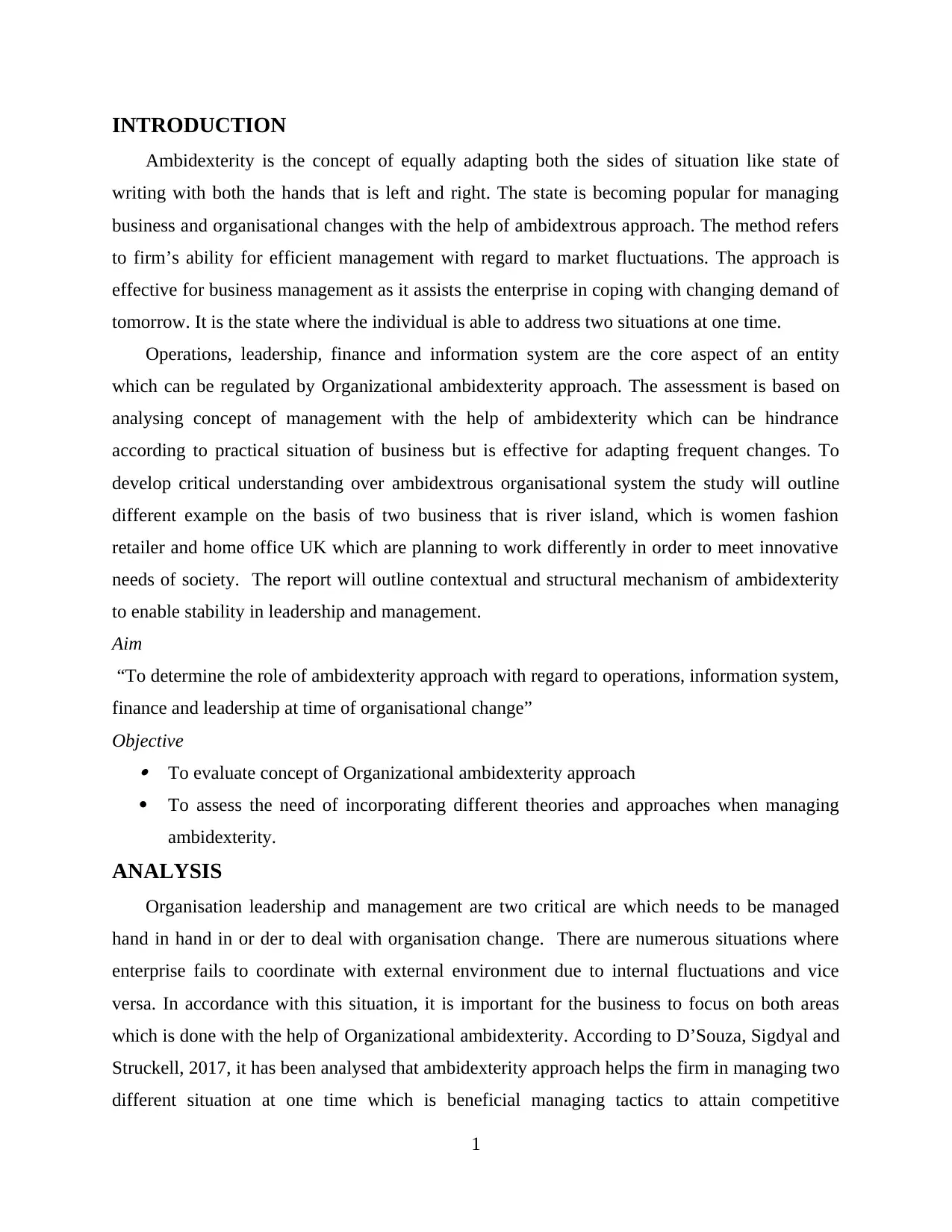
INTRODUCTION
Ambidexterity is the concept of equally adapting both the sides of situation like state of
writing with both the hands that is left and right. The state is becoming popular for managing
business and organisational changes with the help of ambidextrous approach. The method refers
to firm’s ability for efficient management with regard to market fluctuations. The approach is
effective for business management as it assists the enterprise in coping with changing demand of
tomorrow. It is the state where the individual is able to address two situations at one time.
Operations, leadership, finance and information system are the core aspect of an entity
which can be regulated by Organizational ambidexterity approach. The assessment is based on
analysing concept of management with the help of ambidexterity which can be hindrance
according to practical situation of business but is effective for adapting frequent changes. To
develop critical understanding over ambidextrous organisational system the study will outline
different example on the basis of two business that is river island, which is women fashion
retailer and home office UK which are planning to work differently in order to meet innovative
needs of society. The report will outline contextual and structural mechanism of ambidexterity
to enable stability in leadership and management.
Aim
“To determine the role of ambidexterity approach with regard to operations, information system,
finance and leadership at time of organisational change”
Objective To evaluate concept of Organizational ambidexterity approach
To assess the need of incorporating different theories and approaches when managing
ambidexterity.
ANALYSIS
Organisation leadership and management are two critical are which needs to be managed
hand in hand in or der to deal with organisation change. There are numerous situations where
enterprise fails to coordinate with external environment due to internal fluctuations and vice
versa. In accordance with this situation, it is important for the business to focus on both areas
which is done with the help of Organizational ambidexterity. According to D’Souza, Sigdyal and
Struckell, 2017, it has been analysed that ambidexterity approach helps the firm in managing two
different situation at one time which is beneficial managing tactics to attain competitive
1
Ambidexterity is the concept of equally adapting both the sides of situation like state of
writing with both the hands that is left and right. The state is becoming popular for managing
business and organisational changes with the help of ambidextrous approach. The method refers
to firm’s ability for efficient management with regard to market fluctuations. The approach is
effective for business management as it assists the enterprise in coping with changing demand of
tomorrow. It is the state where the individual is able to address two situations at one time.
Operations, leadership, finance and information system are the core aspect of an entity
which can be regulated by Organizational ambidexterity approach. The assessment is based on
analysing concept of management with the help of ambidexterity which can be hindrance
according to practical situation of business but is effective for adapting frequent changes. To
develop critical understanding over ambidextrous organisational system the study will outline
different example on the basis of two business that is river island, which is women fashion
retailer and home office UK which are planning to work differently in order to meet innovative
needs of society. The report will outline contextual and structural mechanism of ambidexterity
to enable stability in leadership and management.
Aim
“To determine the role of ambidexterity approach with regard to operations, information system,
finance and leadership at time of organisational change”
Objective To evaluate concept of Organizational ambidexterity approach
To assess the need of incorporating different theories and approaches when managing
ambidexterity.
ANALYSIS
Organisation leadership and management are two critical are which needs to be managed
hand in hand in or der to deal with organisation change. There are numerous situations where
enterprise fails to coordinate with external environment due to internal fluctuations and vice
versa. In accordance with this situation, it is important for the business to focus on both areas
which is done with the help of Organizational ambidexterity. According to D’Souza, Sigdyal and
Struckell, 2017, it has been analysed that ambidexterity approach helps the firm in managing two
different situation at one time which is beneficial managing tactics to attain competitive
1
⊘ This is a preview!⊘
Do you want full access?
Subscribe today to unlock all pages.

Trusted by 1+ million students worldwide
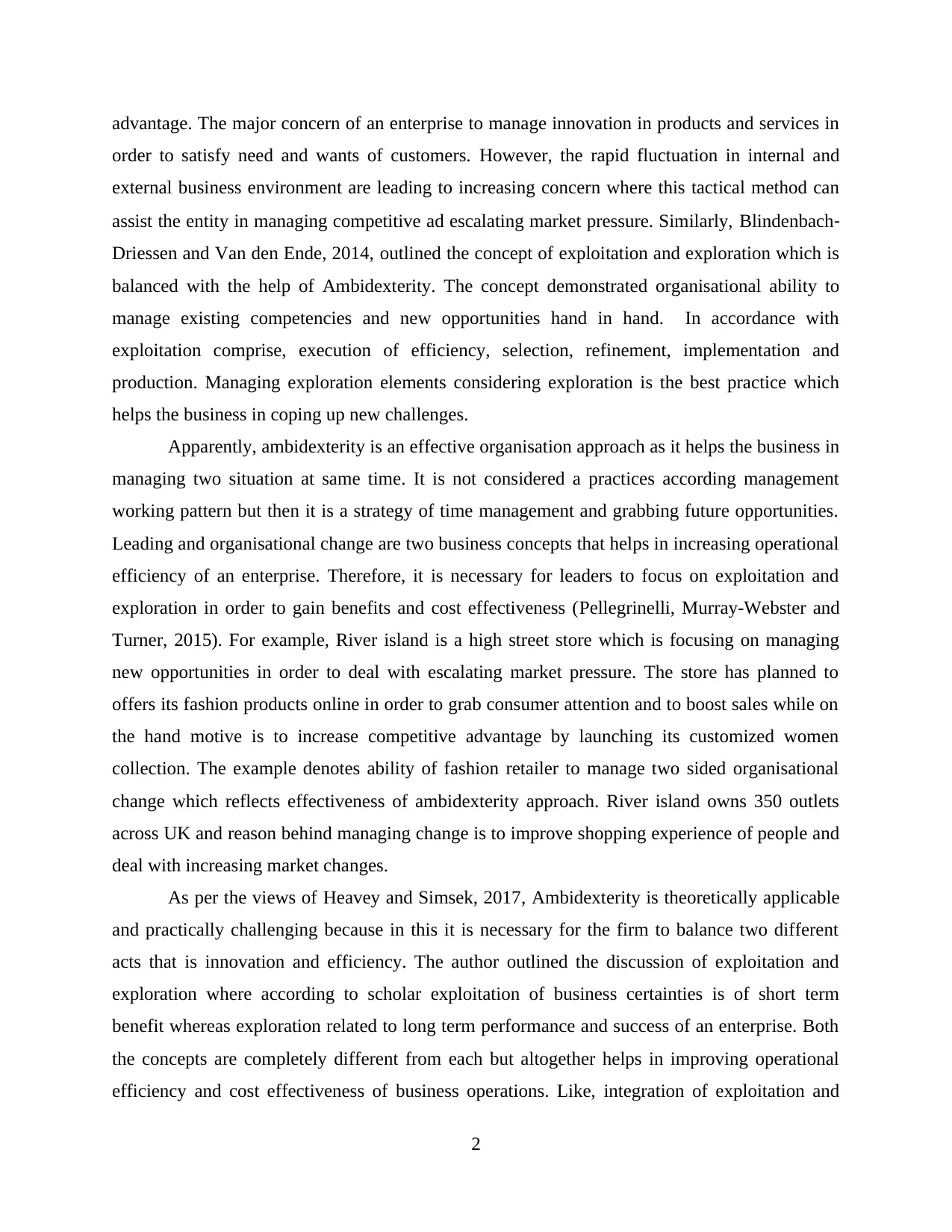
advantage. The major concern of an enterprise to manage innovation in products and services in
order to satisfy need and wants of customers. However, the rapid fluctuation in internal and
external business environment are leading to increasing concern where this tactical method can
assist the entity in managing competitive ad escalating market pressure. Similarly, Blindenbach‐
Driessen and Van den Ende, 2014, outlined the concept of exploitation and exploration which is
balanced with the help of Ambidexterity. The concept demonstrated organisational ability to
manage existing competencies and new opportunities hand in hand. In accordance with
exploitation comprise, execution of efficiency, selection, refinement, implementation and
production. Managing exploration elements considering exploration is the best practice which
helps the business in coping up new challenges.
Apparently, ambidexterity is an effective organisation approach as it helps the business in
managing two situation at same time. It is not considered a practices according management
working pattern but then it is a strategy of time management and grabbing future opportunities.
Leading and organisational change are two business concepts that helps in increasing operational
efficiency of an enterprise. Therefore, it is necessary for leaders to focus on exploitation and
exploration in order to gain benefits and cost effectiveness (Pellegrinelli, Murray-Webster and
Turner, 2015). For example, River island is a high street store which is focusing on managing
new opportunities in order to deal with escalating market pressure. The store has planned to
offers its fashion products online in order to grab consumer attention and to boost sales while on
the hand motive is to increase competitive advantage by launching its customized women
collection. The example denotes ability of fashion retailer to manage two sided organisational
change which reflects effectiveness of ambidexterity approach. River island owns 350 outlets
across UK and reason behind managing change is to improve shopping experience of people and
deal with increasing market changes.
As per the views of Heavey and Simsek, 2017, Ambidexterity is theoretically applicable
and practically challenging because in this it is necessary for the firm to balance two different
acts that is innovation and efficiency. The author outlined the discussion of exploitation and
exploration where according to scholar exploitation of business certainties is of short term
benefit whereas exploration related to long term performance and success of an enterprise. Both
the concepts are completely different from each but altogether helps in improving operational
efficiency and cost effectiveness of business operations. Like, integration of exploitation and
2
order to satisfy need and wants of customers. However, the rapid fluctuation in internal and
external business environment are leading to increasing concern where this tactical method can
assist the entity in managing competitive ad escalating market pressure. Similarly, Blindenbach‐
Driessen and Van den Ende, 2014, outlined the concept of exploitation and exploration which is
balanced with the help of Ambidexterity. The concept demonstrated organisational ability to
manage existing competencies and new opportunities hand in hand. In accordance with
exploitation comprise, execution of efficiency, selection, refinement, implementation and
production. Managing exploration elements considering exploration is the best practice which
helps the business in coping up new challenges.
Apparently, ambidexterity is an effective organisation approach as it helps the business in
managing two situation at same time. It is not considered a practices according management
working pattern but then it is a strategy of time management and grabbing future opportunities.
Leading and organisational change are two business concepts that helps in increasing operational
efficiency of an enterprise. Therefore, it is necessary for leaders to focus on exploitation and
exploration in order to gain benefits and cost effectiveness (Pellegrinelli, Murray-Webster and
Turner, 2015). For example, River island is a high street store which is focusing on managing
new opportunities in order to deal with escalating market pressure. The store has planned to
offers its fashion products online in order to grab consumer attention and to boost sales while on
the hand motive is to increase competitive advantage by launching its customized women
collection. The example denotes ability of fashion retailer to manage two sided organisational
change which reflects effectiveness of ambidexterity approach. River island owns 350 outlets
across UK and reason behind managing change is to improve shopping experience of people and
deal with increasing market changes.
As per the views of Heavey and Simsek, 2017, Ambidexterity is theoretically applicable
and practically challenging because in this it is necessary for the firm to balance two different
acts that is innovation and efficiency. The author outlined the discussion of exploitation and
exploration where according to scholar exploitation of business certainties is of short term
benefit whereas exploration related to long term performance and success of an enterprise. Both
the concepts are completely different from each but altogether helps in improving operational
efficiency and cost effectiveness of business operations. Like, integration of exploitation and
2
Paraphrase This Document
Need a fresh take? Get an instant paraphrase of this document with our AI Paraphraser
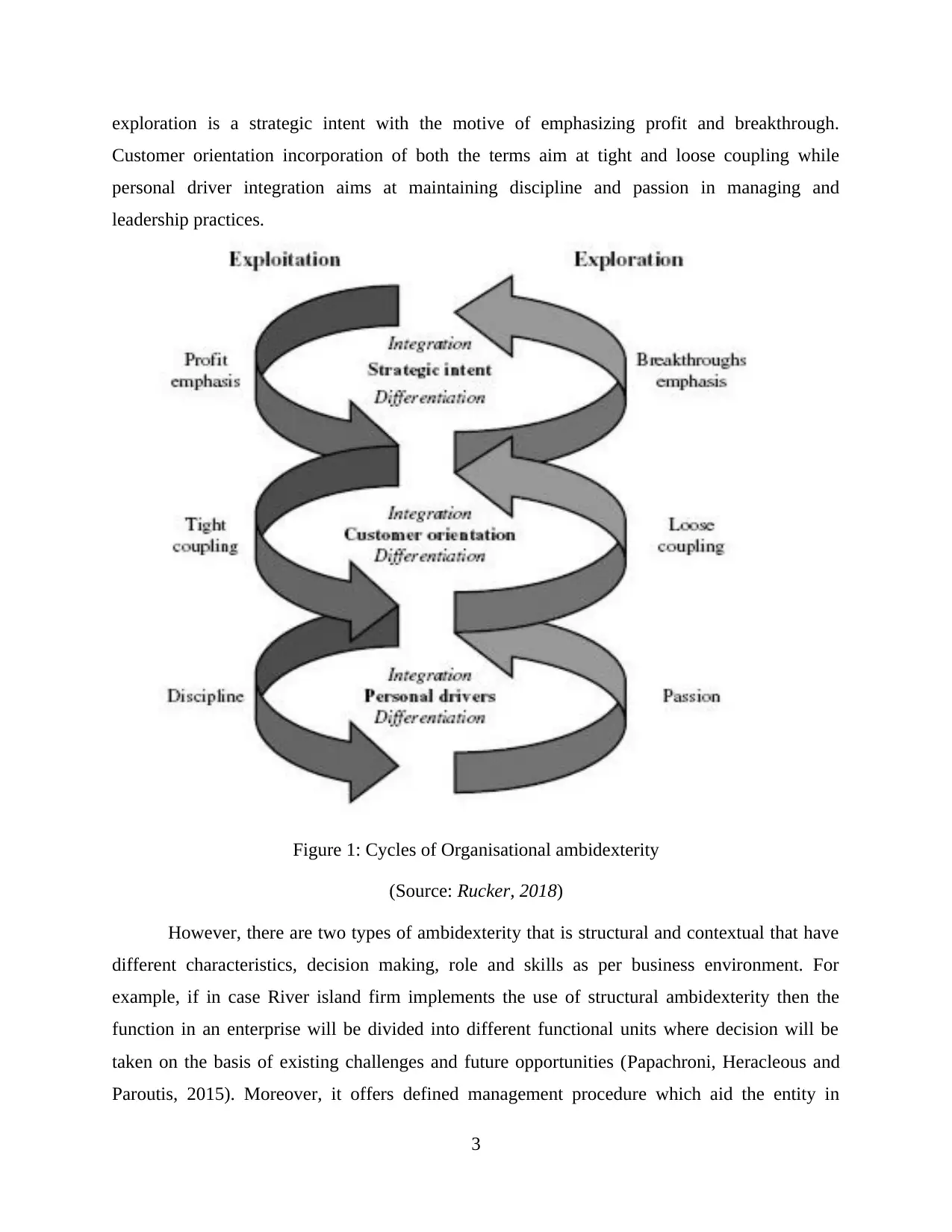
exploration is a strategic intent with the motive of emphasizing profit and breakthrough.
Customer orientation incorporation of both the terms aim at tight and loose coupling while
personal driver integration aims at maintaining discipline and passion in managing and
leadership practices.
Figure 1: Cycles of Organisational ambidexterity
(Source: Rucker, 2018)
However, there are two types of ambidexterity that is structural and contextual that have
different characteristics, decision making, role and skills as per business environment. For
example, if in case River island firm implements the use of structural ambidexterity then the
function in an enterprise will be divided into different functional units where decision will be
taken on the basis of existing challenges and future opportunities (Papachroni, Heracleous and
Paroutis, 2015). Moreover, it offers defined management procedure which aid the entity in
3
Customer orientation incorporation of both the terms aim at tight and loose coupling while
personal driver integration aims at maintaining discipline and passion in managing and
leadership practices.
Figure 1: Cycles of Organisational ambidexterity
(Source: Rucker, 2018)
However, there are two types of ambidexterity that is structural and contextual that have
different characteristics, decision making, role and skills as per business environment. For
example, if in case River island firm implements the use of structural ambidexterity then the
function in an enterprise will be divided into different functional units where decision will be
taken on the basis of existing challenges and future opportunities (Papachroni, Heracleous and
Paroutis, 2015). Moreover, it offers defined management procedure which aid the entity in
3
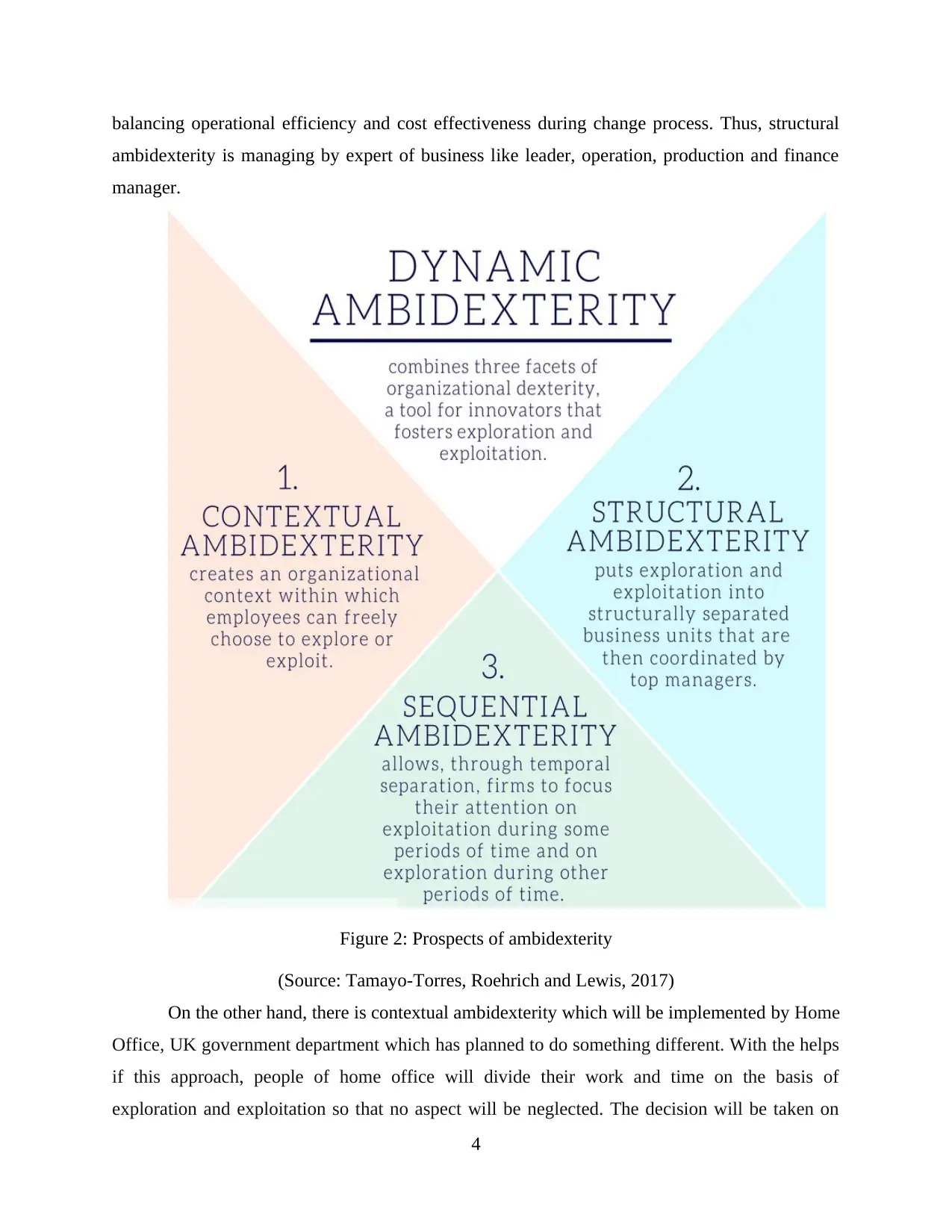
balancing operational efficiency and cost effectiveness during change process. Thus, structural
ambidexterity is managing by expert of business like leader, operation, production and finance
manager.
Figure 2: Prospects of ambidexterity
(Source: Tamayo-Torres, Roehrich and Lewis, 2017)
On the other hand, there is contextual ambidexterity which will be implemented by Home
Office, UK government department which has planned to do something different. With the helps
if this approach, people of home office will divide their work and time on the basis of
exploration and exploitation so that no aspect will be neglected. The decision will be taken on
4
ambidexterity is managing by expert of business like leader, operation, production and finance
manager.
Figure 2: Prospects of ambidexterity
(Source: Tamayo-Torres, Roehrich and Lewis, 2017)
On the other hand, there is contextual ambidexterity which will be implemented by Home
Office, UK government department which has planned to do something different. With the helps
if this approach, people of home office will divide their work and time on the basis of
exploration and exploitation so that no aspect will be neglected. The decision will be taken on
4
⊘ This is a preview!⊘
Do you want full access?
Subscribe today to unlock all pages.

Trusted by 1+ million students worldwide
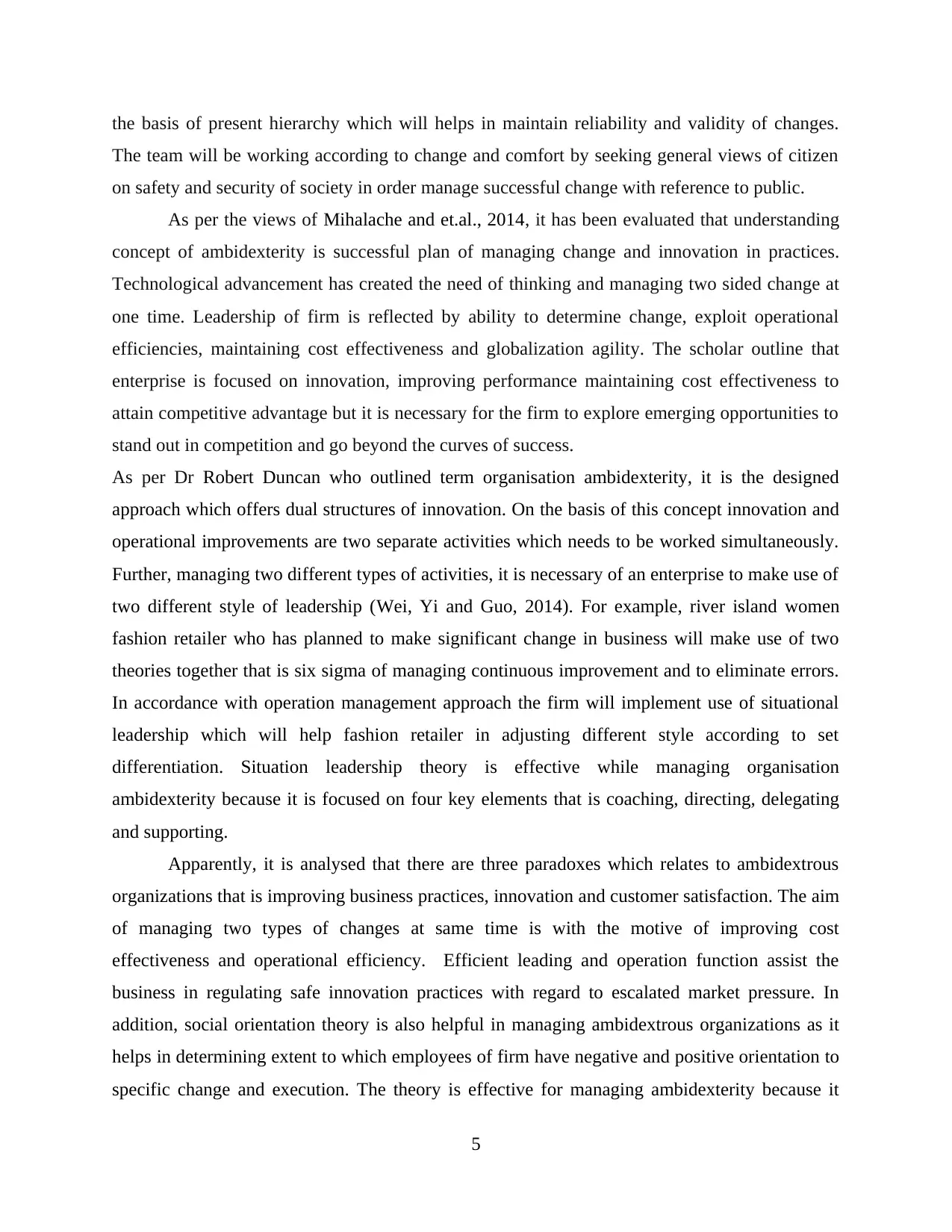
the basis of present hierarchy which will helps in maintain reliability and validity of changes.
The team will be working according to change and comfort by seeking general views of citizen
on safety and security of society in order manage successful change with reference to public.
As per the views of Mihalache and et.al., 2014, it has been evaluated that understanding
concept of ambidexterity is successful plan of managing change and innovation in practices.
Technological advancement has created the need of thinking and managing two sided change at
one time. Leadership of firm is reflected by ability to determine change, exploit operational
efficiencies, maintaining cost effectiveness and globalization agility. The scholar outline that
enterprise is focused on innovation, improving performance maintaining cost effectiveness to
attain competitive advantage but it is necessary for the firm to explore emerging opportunities to
stand out in competition and go beyond the curves of success.
As per Dr Robert Duncan who outlined term organisation ambidexterity, it is the designed
approach which offers dual structures of innovation. On the basis of this concept innovation and
operational improvements are two separate activities which needs to be worked simultaneously.
Further, managing two different types of activities, it is necessary of an enterprise to make use of
two different style of leadership (Wei, Yi and Guo, 2014). For example, river island women
fashion retailer who has planned to make significant change in business will make use of two
theories together that is six sigma of managing continuous improvement and to eliminate errors.
In accordance with operation management approach the firm will implement use of situational
leadership which will help fashion retailer in adjusting different style according to set
differentiation. Situation leadership theory is effective while managing organisation
ambidexterity because it is focused on four key elements that is coaching, directing, delegating
and supporting.
Apparently, it is analysed that there are three paradoxes which relates to ambidextrous
organizations that is improving business practices, innovation and customer satisfaction. The aim
of managing two types of changes at same time is with the motive of improving cost
effectiveness and operational efficiency. Efficient leading and operation function assist the
business in regulating safe innovation practices with regard to escalated market pressure. In
addition, social orientation theory is also helpful in managing ambidextrous organizations as it
helps in determining extent to which employees of firm have negative and positive orientation to
specific change and execution. The theory is effective for managing ambidexterity because it
5
The team will be working according to change and comfort by seeking general views of citizen
on safety and security of society in order manage successful change with reference to public.
As per the views of Mihalache and et.al., 2014, it has been evaluated that understanding
concept of ambidexterity is successful plan of managing change and innovation in practices.
Technological advancement has created the need of thinking and managing two sided change at
one time. Leadership of firm is reflected by ability to determine change, exploit operational
efficiencies, maintaining cost effectiveness and globalization agility. The scholar outline that
enterprise is focused on innovation, improving performance maintaining cost effectiveness to
attain competitive advantage but it is necessary for the firm to explore emerging opportunities to
stand out in competition and go beyond the curves of success.
As per Dr Robert Duncan who outlined term organisation ambidexterity, it is the designed
approach which offers dual structures of innovation. On the basis of this concept innovation and
operational improvements are two separate activities which needs to be worked simultaneously.
Further, managing two different types of activities, it is necessary of an enterprise to make use of
two different style of leadership (Wei, Yi and Guo, 2014). For example, river island women
fashion retailer who has planned to make significant change in business will make use of two
theories together that is six sigma of managing continuous improvement and to eliminate errors.
In accordance with operation management approach the firm will implement use of situational
leadership which will help fashion retailer in adjusting different style according to set
differentiation. Situation leadership theory is effective while managing organisation
ambidexterity because it is focused on four key elements that is coaching, directing, delegating
and supporting.
Apparently, it is analysed that there are three paradoxes which relates to ambidextrous
organizations that is improving business practices, innovation and customer satisfaction. The aim
of managing two types of changes at same time is with the motive of improving cost
effectiveness and operational efficiency. Efficient leading and operation function assist the
business in regulating safe innovation practices with regard to escalated market pressure. In
addition, social orientation theory is also helpful in managing ambidextrous organizations as it
helps in determining extent to which employees of firm have negative and positive orientation to
specific change and execution. The theory is effective for managing ambidexterity because it
5
Paraphrase This Document
Need a fresh take? Get an instant paraphrase of this document with our AI Paraphraser
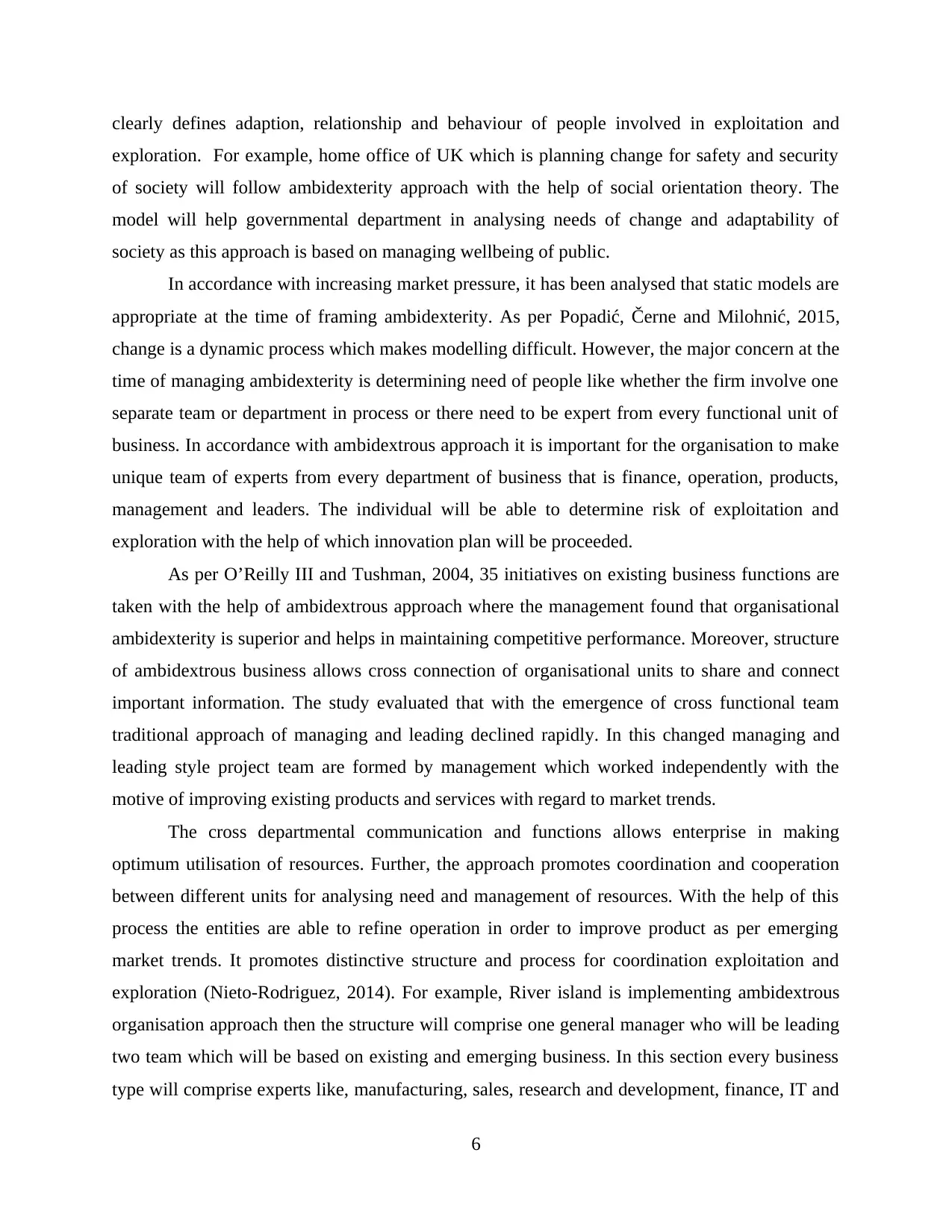
clearly defines adaption, relationship and behaviour of people involved in exploitation and
exploration. For example, home office of UK which is planning change for safety and security
of society will follow ambidexterity approach with the help of social orientation theory. The
model will help governmental department in analysing needs of change and adaptability of
society as this approach is based on managing wellbeing of public.
In accordance with increasing market pressure, it has been analysed that static models are
appropriate at the time of framing ambidexterity. As per Popadić, Černe and Milohnić, 2015,
change is a dynamic process which makes modelling difficult. However, the major concern at the
time of managing ambidexterity is determining need of people like whether the firm involve one
separate team or department in process or there need to be expert from every functional unit of
business. In accordance with ambidextrous approach it is important for the organisation to make
unique team of experts from every department of business that is finance, operation, products,
management and leaders. The individual will be able to determine risk of exploitation and
exploration with the help of which innovation plan will be proceeded.
As per O’Reilly III and Tushman, 2004, 35 initiatives on existing business functions are
taken with the help of ambidextrous approach where the management found that organisational
ambidexterity is superior and helps in maintaining competitive performance. Moreover, structure
of ambidextrous business allows cross connection of organisational units to share and connect
important information. The study evaluated that with the emergence of cross functional team
traditional approach of managing and leading declined rapidly. In this changed managing and
leading style project team are formed by management which worked independently with the
motive of improving existing products and services with regard to market trends.
The cross departmental communication and functions allows enterprise in making
optimum utilisation of resources. Further, the approach promotes coordination and cooperation
between different units for analysing need and management of resources. With the help of this
process the entities are able to refine operation in order to improve product as per emerging
market trends. It promotes distinctive structure and process for coordination exploitation and
exploration (Nieto-Rodriguez, 2014). For example, River island is implementing ambidextrous
organisation approach then the structure will comprise one general manager who will be leading
two team which will be based on existing and emerging business. In this section every business
type will comprise experts like, manufacturing, sales, research and development, finance, IT and
6
exploration. For example, home office of UK which is planning change for safety and security
of society will follow ambidexterity approach with the help of social orientation theory. The
model will help governmental department in analysing needs of change and adaptability of
society as this approach is based on managing wellbeing of public.
In accordance with increasing market pressure, it has been analysed that static models are
appropriate at the time of framing ambidexterity. As per Popadić, Černe and Milohnić, 2015,
change is a dynamic process which makes modelling difficult. However, the major concern at the
time of managing ambidexterity is determining need of people like whether the firm involve one
separate team or department in process or there need to be expert from every functional unit of
business. In accordance with ambidextrous approach it is important for the organisation to make
unique team of experts from every department of business that is finance, operation, products,
management and leaders. The individual will be able to determine risk of exploitation and
exploration with the help of which innovation plan will be proceeded.
As per O’Reilly III and Tushman, 2004, 35 initiatives on existing business functions are
taken with the help of ambidextrous approach where the management found that organisational
ambidexterity is superior and helps in maintaining competitive performance. Moreover, structure
of ambidextrous business allows cross connection of organisational units to share and connect
important information. The study evaluated that with the emergence of cross functional team
traditional approach of managing and leading declined rapidly. In this changed managing and
leading style project team are formed by management which worked independently with the
motive of improving existing products and services with regard to market trends.
The cross departmental communication and functions allows enterprise in making
optimum utilisation of resources. Further, the approach promotes coordination and cooperation
between different units for analysing need and management of resources. With the help of this
process the entities are able to refine operation in order to improve product as per emerging
market trends. It promotes distinctive structure and process for coordination exploitation and
exploration (Nieto-Rodriguez, 2014). For example, River island is implementing ambidextrous
organisation approach then the structure will comprise one general manager who will be leading
two team which will be based on existing and emerging business. In this section every business
type will comprise experts like, manufacturing, sales, research and development, finance, IT and
6
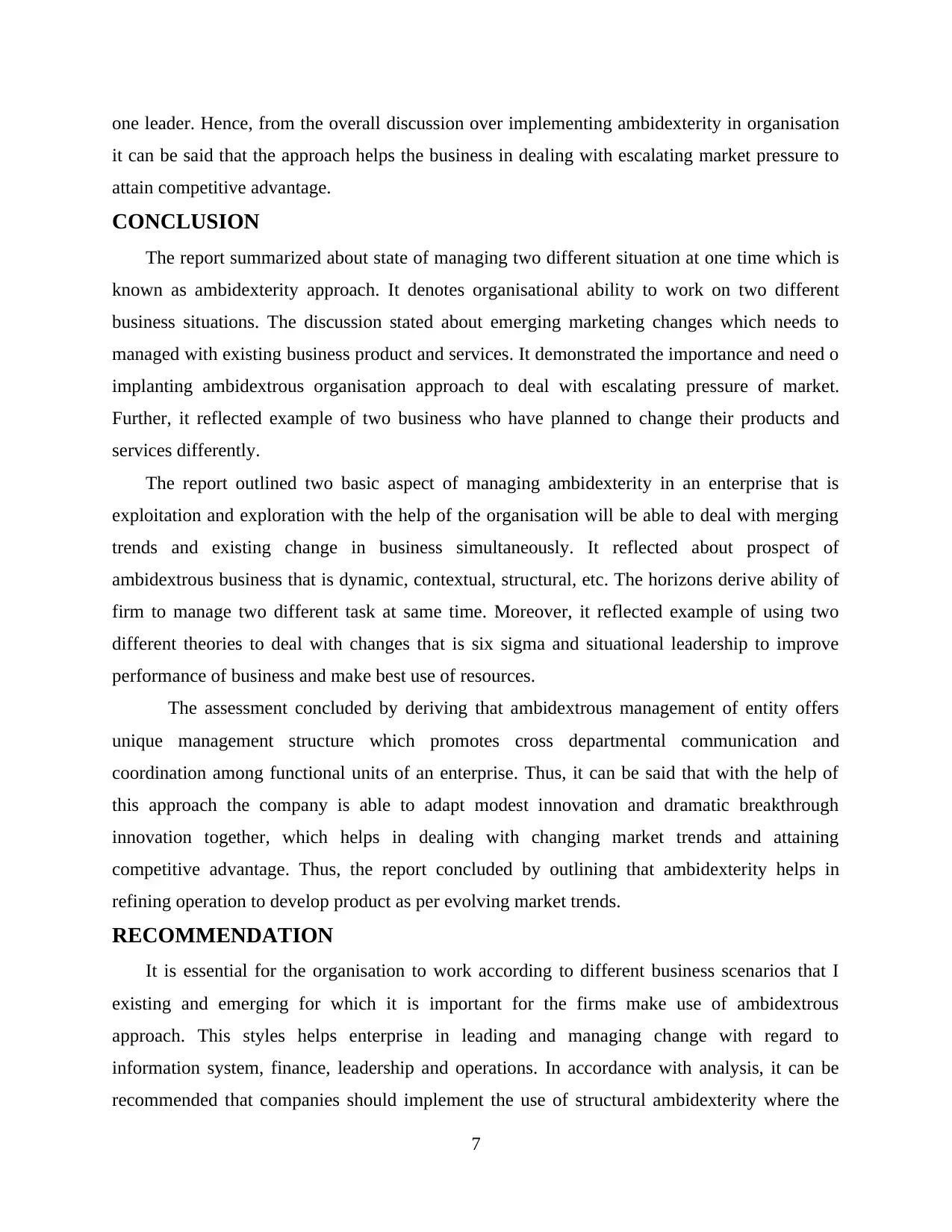
one leader. Hence, from the overall discussion over implementing ambidexterity in organisation
it can be said that the approach helps the business in dealing with escalating market pressure to
attain competitive advantage.
CONCLUSION
The report summarized about state of managing two different situation at one time which is
known as ambidexterity approach. It denotes organisational ability to work on two different
business situations. The discussion stated about emerging marketing changes which needs to
managed with existing business product and services. It demonstrated the importance and need o
implanting ambidextrous organisation approach to deal with escalating pressure of market.
Further, it reflected example of two business who have planned to change their products and
services differently.
The report outlined two basic aspect of managing ambidexterity in an enterprise that is
exploitation and exploration with the help of the organisation will be able to deal with merging
trends and existing change in business simultaneously. It reflected about prospect of
ambidextrous business that is dynamic, contextual, structural, etc. The horizons derive ability of
firm to manage two different task at same time. Moreover, it reflected example of using two
different theories to deal with changes that is six sigma and situational leadership to improve
performance of business and make best use of resources.
The assessment concluded by deriving that ambidextrous management of entity offers
unique management structure which promotes cross departmental communication and
coordination among functional units of an enterprise. Thus, it can be said that with the help of
this approach the company is able to adapt modest innovation and dramatic breakthrough
innovation together, which helps in dealing with changing market trends and attaining
competitive advantage. Thus, the report concluded by outlining that ambidexterity helps in
refining operation to develop product as per evolving market trends.
RECOMMENDATION
It is essential for the organisation to work according to different business scenarios that I
existing and emerging for which it is important for the firms make use of ambidextrous
approach. This styles helps enterprise in leading and managing change with regard to
information system, finance, leadership and operations. In accordance with analysis, it can be
recommended that companies should implement the use of structural ambidexterity where the
7
it can be said that the approach helps the business in dealing with escalating market pressure to
attain competitive advantage.
CONCLUSION
The report summarized about state of managing two different situation at one time which is
known as ambidexterity approach. It denotes organisational ability to work on two different
business situations. The discussion stated about emerging marketing changes which needs to
managed with existing business product and services. It demonstrated the importance and need o
implanting ambidextrous organisation approach to deal with escalating pressure of market.
Further, it reflected example of two business who have planned to change their products and
services differently.
The report outlined two basic aspect of managing ambidexterity in an enterprise that is
exploitation and exploration with the help of the organisation will be able to deal with merging
trends and existing change in business simultaneously. It reflected about prospect of
ambidextrous business that is dynamic, contextual, structural, etc. The horizons derive ability of
firm to manage two different task at same time. Moreover, it reflected example of using two
different theories to deal with changes that is six sigma and situational leadership to improve
performance of business and make best use of resources.
The assessment concluded by deriving that ambidextrous management of entity offers
unique management structure which promotes cross departmental communication and
coordination among functional units of an enterprise. Thus, it can be said that with the help of
this approach the company is able to adapt modest innovation and dramatic breakthrough
innovation together, which helps in dealing with changing market trends and attaining
competitive advantage. Thus, the report concluded by outlining that ambidexterity helps in
refining operation to develop product as per evolving market trends.
RECOMMENDATION
It is essential for the organisation to work according to different business scenarios that I
existing and emerging for which it is important for the firms make use of ambidextrous
approach. This styles helps enterprise in leading and managing change with regard to
information system, finance, leadership and operations. In accordance with analysis, it can be
recommended that companies should implement the use of structural ambidexterity where the
7
⊘ This is a preview!⊘
Do you want full access?
Subscribe today to unlock all pages.

Trusted by 1+ million students worldwide
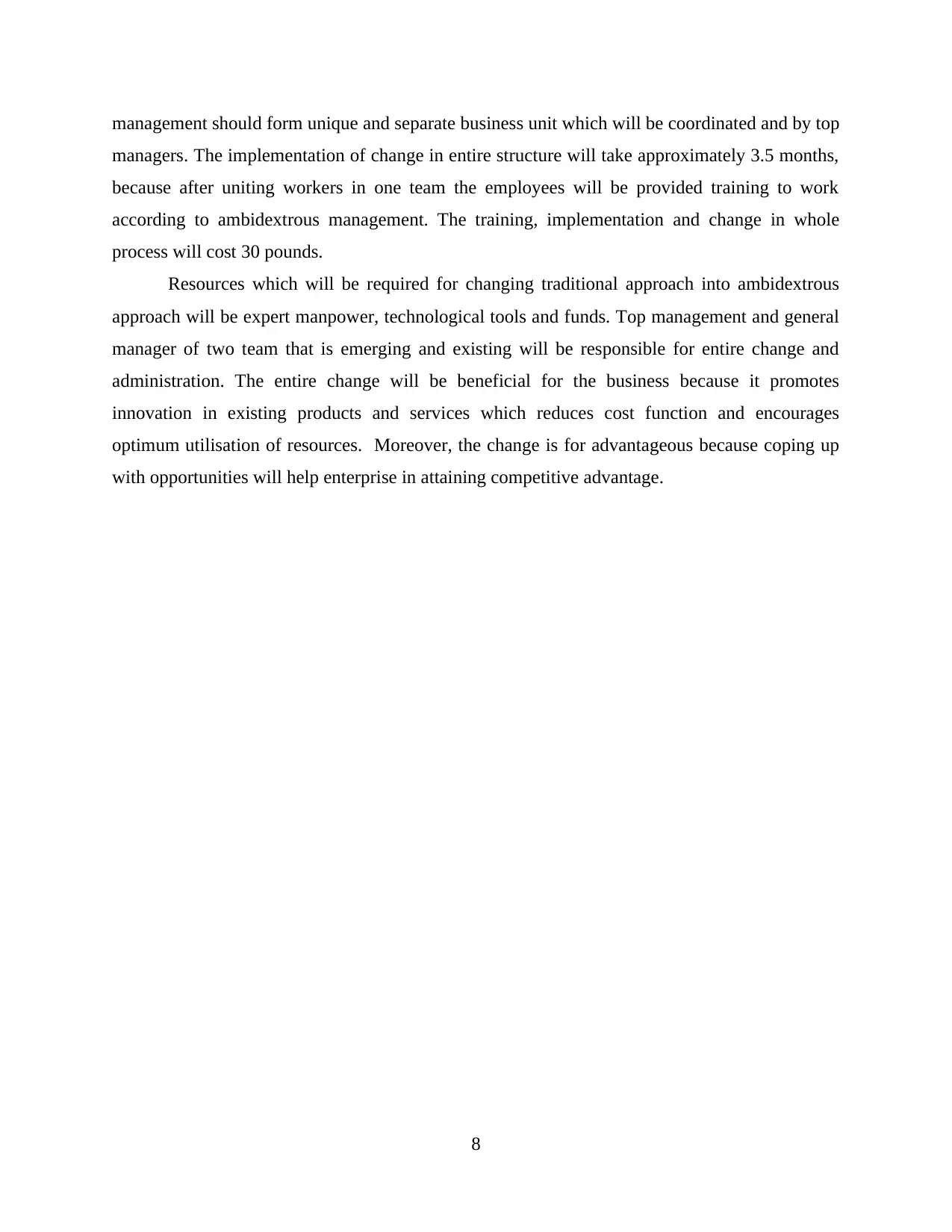
management should form unique and separate business unit which will be coordinated and by top
managers. The implementation of change in entire structure will take approximately 3.5 months,
because after uniting workers in one team the employees will be provided training to work
according to ambidextrous management. The training, implementation and change in whole
process will cost 30 pounds.
Resources which will be required for changing traditional approach into ambidextrous
approach will be expert manpower, technological tools and funds. Top management and general
manager of two team that is emerging and existing will be responsible for entire change and
administration. The entire change will be beneficial for the business because it promotes
innovation in existing products and services which reduces cost function and encourages
optimum utilisation of resources. Moreover, the change is for advantageous because coping up
with opportunities will help enterprise in attaining competitive advantage.
8
managers. The implementation of change in entire structure will take approximately 3.5 months,
because after uniting workers in one team the employees will be provided training to work
according to ambidextrous management. The training, implementation and change in whole
process will cost 30 pounds.
Resources which will be required for changing traditional approach into ambidextrous
approach will be expert manpower, technological tools and funds. Top management and general
manager of two team that is emerging and existing will be responsible for entire change and
administration. The entire change will be beneficial for the business because it promotes
innovation in existing products and services which reduces cost function and encourages
optimum utilisation of resources. Moreover, the change is for advantageous because coping up
with opportunities will help enterprise in attaining competitive advantage.
8
Paraphrase This Document
Need a fresh take? Get an instant paraphrase of this document with our AI Paraphraser
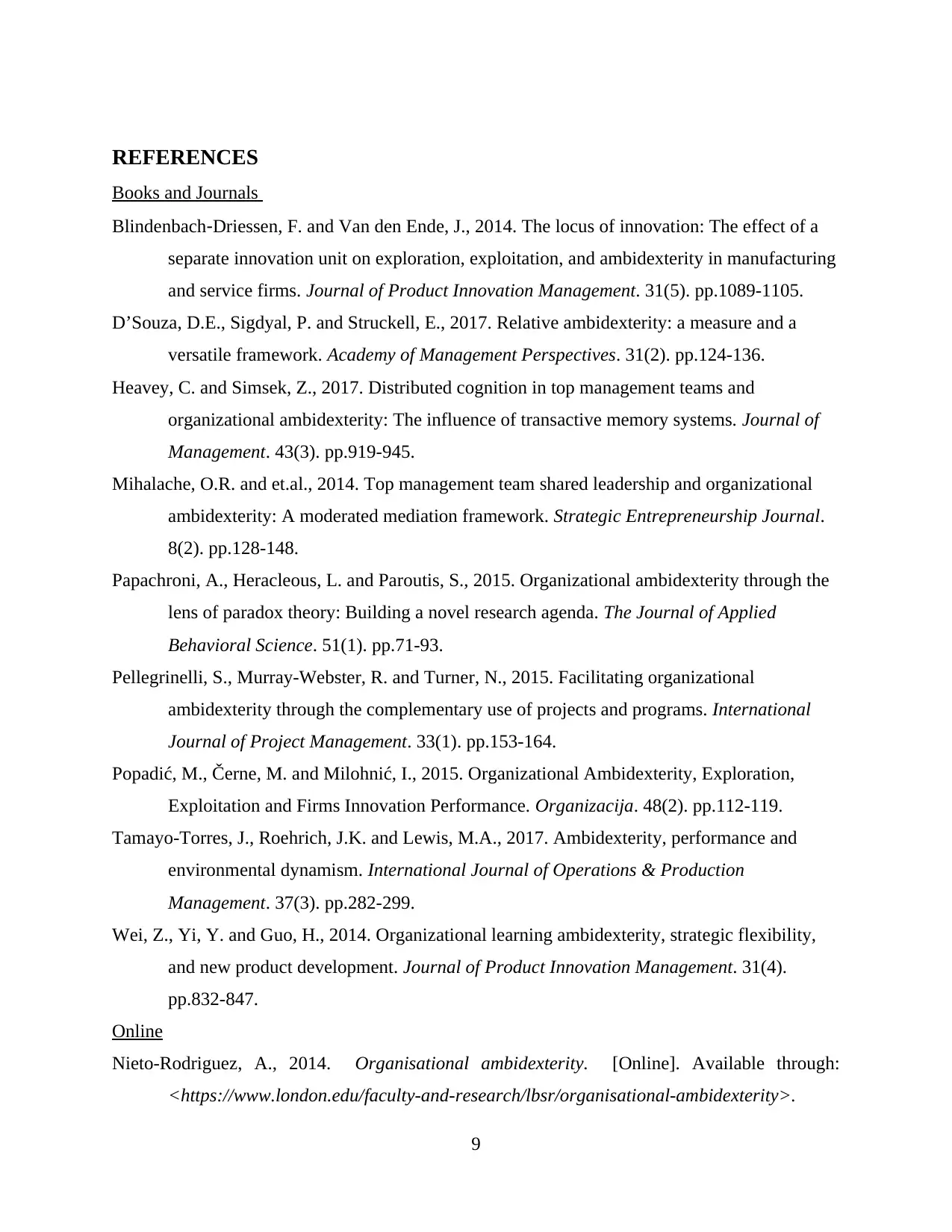
REFERENCES
Books and Journals
Blindenbach‐Driessen, F. and Van den Ende, J., 2014. The locus of innovation: The effect of a
separate innovation unit on exploration, exploitation, and ambidexterity in manufacturing
and service firms. Journal of Product Innovation Management. 31(5). pp.1089-1105.
D’Souza, D.E., Sigdyal, P. and Struckell, E., 2017. Relative ambidexterity: a measure and a
versatile framework. Academy of Management Perspectives. 31(2). pp.124-136.
Heavey, C. and Simsek, Z., 2017. Distributed cognition in top management teams and
organizational ambidexterity: The influence of transactive memory systems. Journal of
Management. 43(3). pp.919-945.
Mihalache, O.R. and et.al., 2014. Top management team shared leadership and organizational
ambidexterity: A moderated mediation framework. Strategic Entrepreneurship Journal.
8(2). pp.128-148.
Papachroni, A., Heracleous, L. and Paroutis, S., 2015. Organizational ambidexterity through the
lens of paradox theory: Building a novel research agenda. The Journal of Applied
Behavioral Science. 51(1). pp.71-93.
Pellegrinelli, S., Murray-Webster, R. and Turner, N., 2015. Facilitating organizational
ambidexterity through the complementary use of projects and programs. International
Journal of Project Management. 33(1). pp.153-164.
Popadić, M., Černe, M. and Milohnić, I., 2015. Organizational Ambidexterity, Exploration,
Exploitation and Firms Innovation Performance. Organizacija. 48(2). pp.112-119.
Tamayo-Torres, J., Roehrich, J.K. and Lewis, M.A., 2017. Ambidexterity, performance and
environmental dynamism. International Journal of Operations & Production
Management. 37(3). pp.282-299.
Wei, Z., Yi, Y. and Guo, H., 2014. Organizational learning ambidexterity, strategic flexibility,
and new product development. Journal of Product Innovation Management. 31(4).
pp.832-847.
Online
Nieto-Rodriguez, A., 2014. Organisational ambidexterity. [Online]. Available through:
<https://www.london.edu/faculty-and-research/lbsr/organisational-ambidexterity>.
9
Books and Journals
Blindenbach‐Driessen, F. and Van den Ende, J., 2014. The locus of innovation: The effect of a
separate innovation unit on exploration, exploitation, and ambidexterity in manufacturing
and service firms. Journal of Product Innovation Management. 31(5). pp.1089-1105.
D’Souza, D.E., Sigdyal, P. and Struckell, E., 2017. Relative ambidexterity: a measure and a
versatile framework. Academy of Management Perspectives. 31(2). pp.124-136.
Heavey, C. and Simsek, Z., 2017. Distributed cognition in top management teams and
organizational ambidexterity: The influence of transactive memory systems. Journal of
Management. 43(3). pp.919-945.
Mihalache, O.R. and et.al., 2014. Top management team shared leadership and organizational
ambidexterity: A moderated mediation framework. Strategic Entrepreneurship Journal.
8(2). pp.128-148.
Papachroni, A., Heracleous, L. and Paroutis, S., 2015. Organizational ambidexterity through the
lens of paradox theory: Building a novel research agenda. The Journal of Applied
Behavioral Science. 51(1). pp.71-93.
Pellegrinelli, S., Murray-Webster, R. and Turner, N., 2015. Facilitating organizational
ambidexterity through the complementary use of projects and programs. International
Journal of Project Management. 33(1). pp.153-164.
Popadić, M., Černe, M. and Milohnić, I., 2015. Organizational Ambidexterity, Exploration,
Exploitation and Firms Innovation Performance. Organizacija. 48(2). pp.112-119.
Tamayo-Torres, J., Roehrich, J.K. and Lewis, M.A., 2017. Ambidexterity, performance and
environmental dynamism. International Journal of Operations & Production
Management. 37(3). pp.282-299.
Wei, Z., Yi, Y. and Guo, H., 2014. Organizational learning ambidexterity, strategic flexibility,
and new product development. Journal of Product Innovation Management. 31(4).
pp.832-847.
Online
Nieto-Rodriguez, A., 2014. Organisational ambidexterity. [Online]. Available through:
<https://www.london.edu/faculty-and-research/lbsr/organisational-ambidexterity>.
9
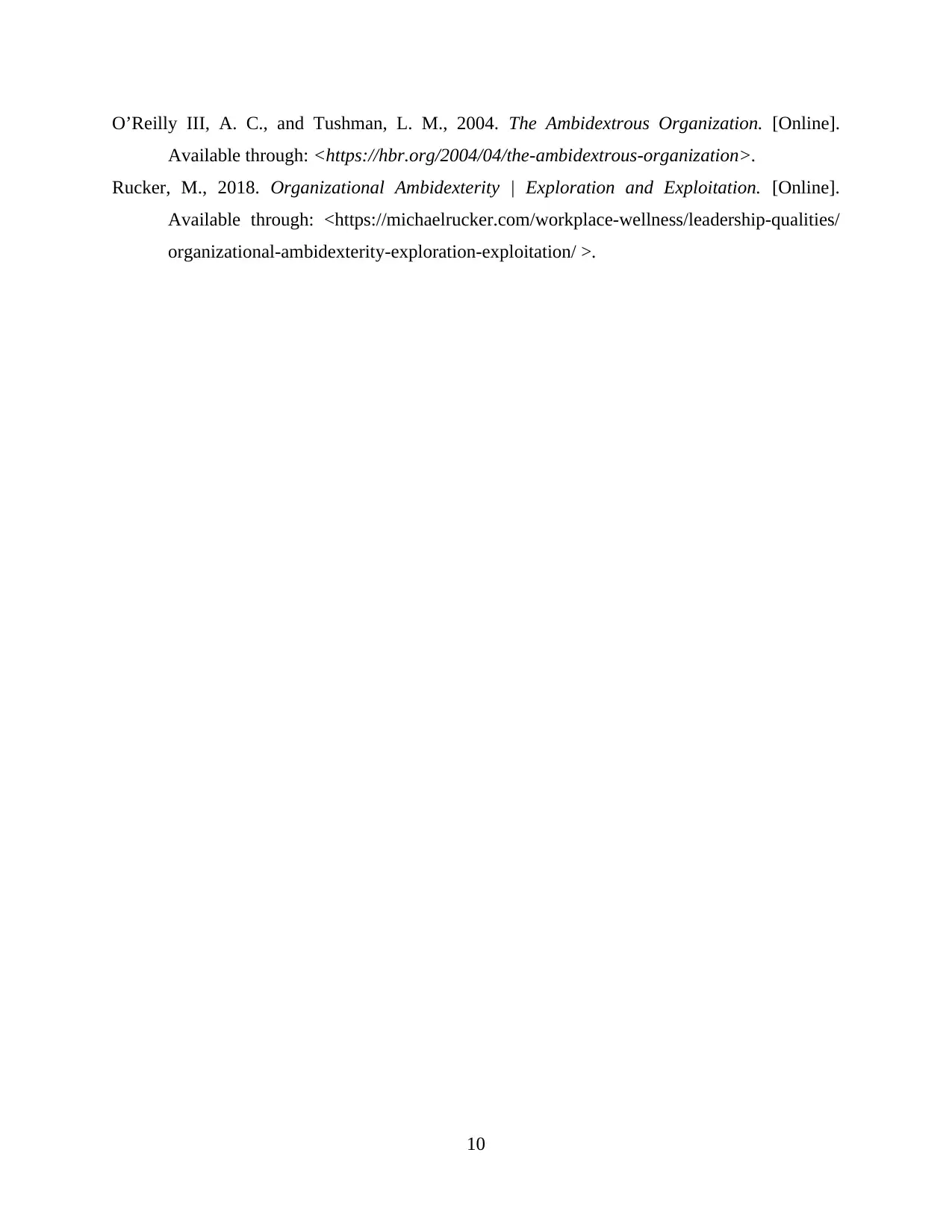
O’Reilly III, A. C., and Tushman, L. M., 2004. The Ambidextrous Organization. [Online].
Available through: <https://hbr.org/2004/04/the-ambidextrous-organization>.
Rucker, M., 2018. Organizational Ambidexterity | Exploration and Exploitation. [Online].
Available through: <https://michaelrucker.com/workplace-wellness/leadership-qualities/
organizational-ambidexterity-exploration-exploitation/ >.
10
Available through: <https://hbr.org/2004/04/the-ambidextrous-organization>.
Rucker, M., 2018. Organizational Ambidexterity | Exploration and Exploitation. [Online].
Available through: <https://michaelrucker.com/workplace-wellness/leadership-qualities/
organizational-ambidexterity-exploration-exploitation/ >.
10
⊘ This is a preview!⊘
Do you want full access?
Subscribe today to unlock all pages.

Trusted by 1+ million students worldwide
1 out of 12
Related Documents
Your All-in-One AI-Powered Toolkit for Academic Success.
+13062052269
info@desklib.com
Available 24*7 on WhatsApp / Email
![[object Object]](/_next/static/media/star-bottom.7253800d.svg)
Unlock your academic potential
Copyright © 2020–2025 A2Z Services. All Rights Reserved. Developed and managed by ZUCOL.





